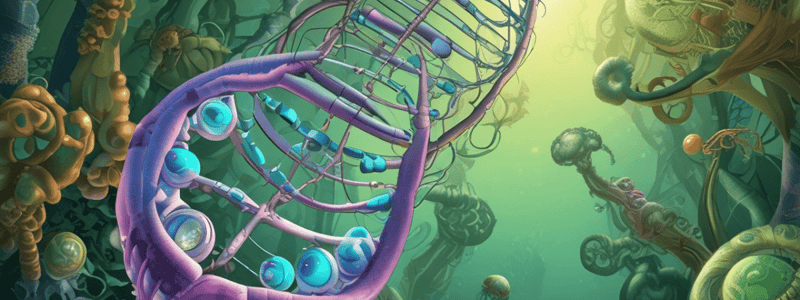Podcast
Questions and Answers
What is the main goal of genetic modification in organisms?
What is the main goal of genetic modification in organisms?
To express desired traits.
How do genetically modified organisms (GMOs) benefit farmers?
How do genetically modified organisms (GMOs) benefit farmers?
They yield more product with crops that are not eaten by pests or overcome by weeds.
What is the definition of a clone?
What is the definition of a clone?
An exact genetic copy of the parent.
What is the role of the plant in the food web?
What is the role of the plant in the food web?
How does genetic variation contribute to the evolution of organisms?
How does genetic variation contribute to the evolution of organisms?
What is the main difference between mitosis and meiosis?
What is the main difference between mitosis and meiosis?
How do offspring receive their genetic information, and what is the resulting outcome?
How do offspring receive their genetic information, and what is the resulting outcome?
What is the key difference between asexual and sexual reproduction in terms of genetic variation?
What is the key difference between asexual and sexual reproduction in terms of genetic variation?
How do meiosis and mitosis differ in their reproductive processes and outcomes?
How do meiosis and mitosis differ in their reproductive processes and outcomes?
What advantage does sexual reproduction offer in terms of genetic variation, and why is this important?
What advantage does sexual reproduction offer in terms of genetic variation, and why is this important?
How do genes and traits relate to each other, and what is the significance of this relationship?
How do genes and traits relate to each other, and what is the significance of this relationship?
What is the significance of fertilization in the process of sexual reproduction, and what is its outcome?
What is the significance of fertilization in the process of sexual reproduction, and what is its outcome?
How does codominance differ from incomplete dominance in the expression of traits?
How does codominance differ from incomplete dominance in the expression of traits?
What is the significance of multiple alleles in the determination of a trait?
What is the significance of multiple alleles in the determination of a trait?
How does the DNA of offspring compare to that of the parents in sexual reproduction?
How does the DNA of offspring compare to that of the parents in sexual reproduction?
What is the role of fertilization in sexual reproduction?
What is the role of fertilization in sexual reproduction?
How does the roan color pattern in cattle, horses, and dogs illustrate codominance?
How does the roan color pattern in cattle, horses, and dogs illustrate codominance?
What is the difference between the genetic material contributed by the sperm and egg cells in sexual reproduction?
What is the difference between the genetic material contributed by the sperm and egg cells in sexual reproduction?
What is the significance of a Punnett Square in determining genotype and phenotype combinations, and how does it relate to genetic variation?
What is the significance of a Punnett Square in determining genotype and phenotype combinations, and how does it relate to genetic variation?
Compare and contrast the processes of meiosis and mitosis in terms of their purpose and outcome in genetic variation.
Compare and contrast the processes of meiosis and mitosis in terms of their purpose and outcome in genetic variation.
What is the role of sexual reproduction in increasing genetic variation, and how does it differ from asexual reproduction?
What is the role of sexual reproduction in increasing genetic variation, and how does it differ from asexual reproduction?
What is the principle behind genetic modification, and how does it differ from cloning?
What is the principle behind genetic modification, and how does it differ from cloning?
How does biotechnology, including genetic modification and cloning, impact the individual, society, and the environment?
How does biotechnology, including genetic modification and cloning, impact the individual, society, and the environment?
What is the significance of the fossil record in providing evidence for evolution, and how does it support the concept of genetic variation?
What is the significance of the fossil record in providing evidence for evolution, and how does it support the concept of genetic variation?
What is the primary purpose of formulating a hypothesis in an investigation, and how does it relate to identifying variables?
What is the primary purpose of formulating a hypothesis in an investigation, and how does it relate to identifying variables?
In the context of the investigation on mealworms, what is the role of a controlled environment, and why is it essential?
In the context of the investigation on mealworms, what is the role of a controlled environment, and why is it essential?
How does replication differ from repetition in scientific experiments, and what is the purpose of each?
How does replication differ from repetition in scientific experiments, and what is the purpose of each?
What are the key elements missing in Gregor's investigation that prevent it from being a scientific experiment?
What are the key elements missing in Gregor's investigation that prevent it from being a scientific experiment?
What is the purpose of labeling and segregating the plastic bags in the seed germination experiment, and how does this relate to the concept of variables?
What is the purpose of labeling and segregating the plastic bags in the seed germination experiment, and how does this relate to the concept of variables?
How does the concept of variables relate to the investigation on rabbit and wolf populations, and what conclusion can be drawn from the data?
How does the concept of variables relate to the investigation on rabbit and wolf populations, and what conclusion can be drawn from the data?
Flashcards are hidden until you start studying




